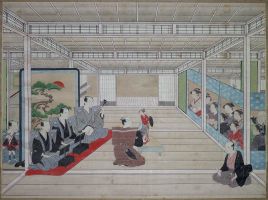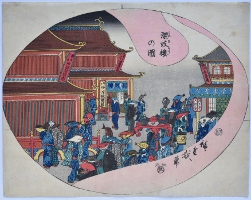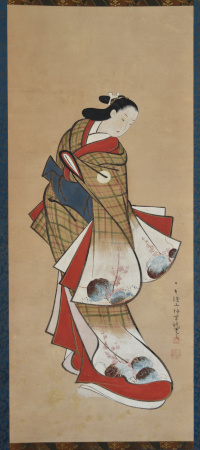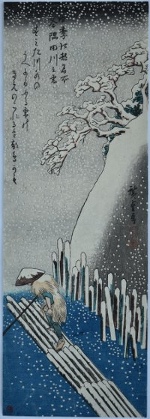Kitagawa UTAMARO (1754-1806)
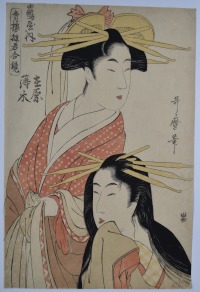
Click here to view image full size.
A double-bust portrait of the famous courtesans Ariwara (bottom) and Usumizu of the Tsuruya House in the Yoshiwara, Edo. From a set Seiro yukun awase kagami, “Mirror of Courtesans of the Green Houses.” Published by Yamada, c 1797.
Fine impression. Very good colour. Very slight trimming, otherwise very good condition. Signed Utamaro hitsu.
Status: Available
Kubo SHUNMAN (1757-1820)
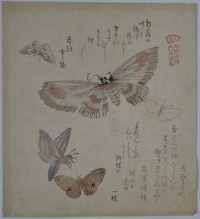
Click here to view image full size.
One of a series of surimono with title: Guncho gafu, “ Pictorial Record of a Swarm of Butterflies.” (In fact butterflies and moths.) Shunman is recognised as possibly the greatest designer of surimono and the prints from this set are amongst the most beautifully printed in this field. His family were printers and this would explain their particular excellence. In fact it is possible that Shunman engraved and printed himself which would account for his seal on other artists’ surimono. Issued c 1810s by the Kasumi-ren poetry club. (Their seal above the signature, top right, Kasumi-ren guncho gafu.) There are copies of the prints from this set which can be very misleading. Two other genuine impressions are in Harvard, 1933.4.1375 and the Met, JP2356.
Very fine impression. Fine colour. Slight discolouration and crinkling at the corners, otherwise good condition. Signed Sho Shunman sei.
Status: Available
Kitagawa UTAMARO (1754-1806)
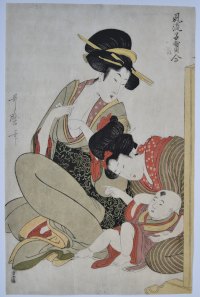
Click here to view image full size.
A design from a set of six prints Furyu ko-dakara awase, “Elegant Comparisons of Little Treasures.” About to breastfeed (chichi). Published by Izumiya Ichibei, c 1802.
Fine impression. Extremely well preserved colour. Very good condition. Signed Utamaro hitsu.
Status: Available
Ikeda EISEN (1790-1848)
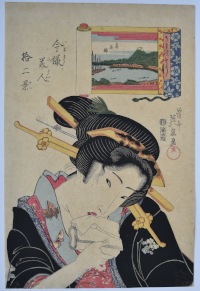
Click here to view image full size.
A beauty, Ureshi so, “The Contented Type” from a set Imayo bijin junikei, “Twelve Views of Modern Beauties.” Above on a handscroll is a view of Fuji from Takanawa. She bites onto a tissue which has erotic connotations. Published c 1822-25 by Izumiya Ichibei.
Fine impression and colour. Very good condition. Signed Keisai Eisen ga.
Status: Available
Utagawa KUNIYOSHI (1797-1861)
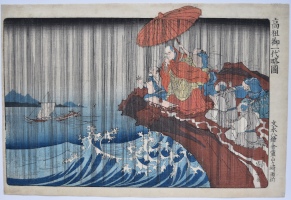
Click here to view image full size.
The priest Nichiren standing on the rocky promontory at Reizan in Kamakura and having his prayers for rain answered. The event occurred in 1271. His disciples surround him and protect him from the deluge with a large umbrella. Bunei hachi Kamakura Reizan-ga-saki uki. The second best design from Koso [Nichiren] goichidai ryakuza, “Illustrated Abridged Biography of the Founder.” Nichiren (1222-1282) was the founder of the Buddhist Nichiren sect (Nichiren shu – Kuniyoshi being a follower) and indeed the set of ten prints may have been commissioned to mark the 550th anniversary of his death. Published by Iseya Rihei, c 1831.
Fine impression, colour and condition. Ample room on top border for the umbrella which protrudes beyond the border and is often trimmed off, as is the information on right border. Signed Ichiyusai Kuniyoshi ga.
Status: Available
Tsukioka SETTEI (1710-1786)

Click here to view image full size.
An original painting, sumi and full colour on silk, 38 x 12.5 in; 96 x 32 cms. Settei produced many illustrated books but after around 1765 turned towards painting beauties, courtesans and geishas. They are of the utmost refinement – the faces and limbs often delineated in red and their costumes embellished with gold. Settei is also known for his elegant shunga. A beauty looks towards a weeping willow. Painted c 1770. In good condition with an elaborately stencilled and embroidered mount. Details picked out in gold.
Signed Hokkyo Tsukioka Settei dzu and sealed o’Shinten.
Status: Available
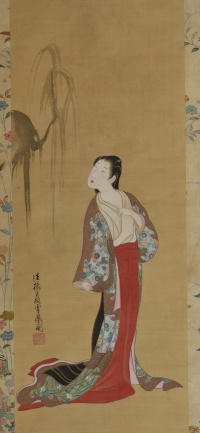
Click here to view image full size.
Matsumura KEIBUN (1779-1843)

Click here to view image full size.
An original painting, sumi and very light colour on paper, 52.5 x 20 in; 133.5 x 51 cms. Keibun studied with his older half-brother Matsumura Goshun as well as Maruyama Okyo. At his best, the equal of Goshun. Noted for his kachoga, as here, showing a bird on a flowering branch and a gourd vine.
In good condition. Signed and sealed Keibun.
Status: Available
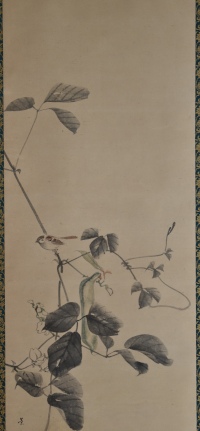
Click here to view image full size.
Hishikawa MORONOBU (?-1694)

Click here to view image full size.
A large sumizuri-e from a shunga set of twelve published c 1680s. In each case the couples are enclosed in a Chinese-style fan border. A couple in flagrante delicto beside an engawa with a bird cage. Moronobu was possibly the single most influential artist and pioneered the ukiyo-e school. A painter, printer and illustrator.
Very good impression. Minor marks, otherwise good condition.
Status: Available
Hishikawa MORONOBU (?-1694)

Click here to view image full size.
A large sumizuri-e from a shunga set of twelve published c 1680s. In each case the couples are enclosed in a Chinese-style fan border. A couple in flagrante delicto. Moronobu was possibly the single most influential artist and pioneered the ukiyo-e school. A painter, printer and illustrator.
Very good impression. Minor marks, otherwise good condition.
Status: Available
Hishikawa MORONOBU (?-1694)

Click here to view image full size.
A large sumizuri-e from a shunga set of twelve published c 1680s. In each case the couples are enclosed in a Chinese-style fan border. A couple in flagrante delicto. Moronobu was possibly the single most influential artist and pioneered the ukiyo-e school. A painter, printer and illustrator.
Very good impression. Minor marks, otherwise good condition.
Status: Available
Hishikawa MORONOBU (?-1694)

Click here to view image full size.
A large sumizuri-e from a shunga set of twelve published c 1680s. In each case the couples are enclosed in a Chinese-style fan border. A couple in flagrante delicto. Moronobu was possibly the single most influential artist and pioneered the ukiyo-e school. A painter, printer and illustrator.
Very good impression. Minor marks, otherwise good condition.
Status: Available
Hishikawa MORONOBU (?-1694)

Click here to view image full size.
A large sumizuri-e from a shunga set of twelve published c 1680s. In each case the couples are enclosed in a Chinese-style fan border. A couple in flagrante delicto. Moronobu was possibly the single most influential artist and pioneered the ukiyo-e school. A painter, printer and illustrator.
Very good impression. Minor marks, otherwise good condition.
Status: Available
Utagawa HIROSHIGE II (1826-1869)
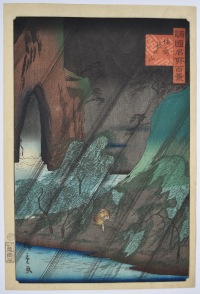
Click here to view image full size.
The Dragon’s Maw Mountain, Bizen Province, Bizen tatsu-no-kuchiyama from Shokoku meisho hyakkei, “Hundred Views of Famous Places in the Provinces.” An uncompleted set of 81 prints published by Uoya Eikichi between 1859-1861 (this being 1861). Shows a lone figure battling a heavy rainstorm in a steep-sided canyon.
Superb impression of the first edition. Fine colour and condition. Signed Hiroshige ga.
Status: Available
Utagawa HIROSHIGE II (1826-1869)
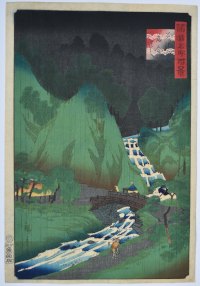
Click here to view image full size.
Mino Ochiai-bashi. Mino (Noshu) Province from Shokoku meisho hyakkei, “Hundred Views of Famous Places in the Provinces.” An uncompleted set of 81 prints published by Uoya Eikichi between 1859-1861 (this being 1861). An evening rain scene with figures making their way across the torrential Chitose River, famous for its fishing.
Superb impression of the first edition. Fine colour and condition. Signed Hiroshige ga.
Status: Available
Utagawa KUNISADA (1786-1864)
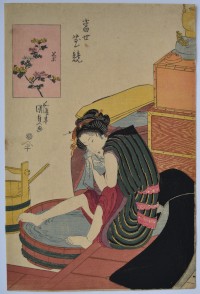
Click here to view image full size.
A beauty washing in a large tub of water. Kiku,”Chrysanthemum” from a set Tosei hana kurabe, “Contest of Modern Flowers.”Beauties compared to flowers. Published by Omiya Heihachi, c 1820. This appears to be the earliest state with the beauty’s undergarment printed red which is lacking in other impressions.
Very good impression. Fine colour. Very good condition. Signed Gototei Kunisada ga.
Status: Available
Utagawa KUNISADA (1786-1864)
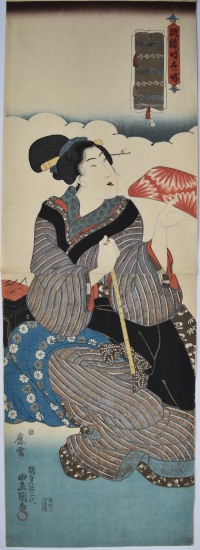
Click here to view image full size.
A vertical double oban showing a woman holding a ruler and offering a small bolt of cloth with the other hand. From a set Atsurae ori jisei konomi, “Fabrics to Order in Current Taste.” Published by Yamashiroya Jinbei, c 1843-7. A rare design from a rare set, and even rarer to find in this condition as most examples have been mounted and consequently damaged from being hung.
Very fine impression. Fine colour and condition. Signed Oju Kunisada aratame Nidai Toyokuni ga.
Status: Available
Tsukioka YOSHITOSHI (1839-1892)
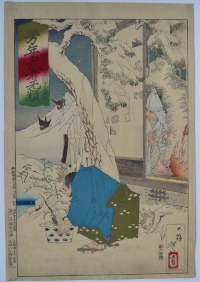
Click here to view image full size.
Shows Sano Genzaemon Tsuneyo in his snowy garden about to cut his precious bonsai to provide kindling to cook a meal for an unexpected visitor. The guest, disguised as a monk, was in fact the retired regent Hojo Tokiyori (1226-1263) on an intelligence mission. He is shown peering through the shoji. From a set Yoshitoshi musha burui, “Yoshitoshi’s Courageous Warriors” published by Kobayashi Tetsujiro, 1883. This is the first edition with the heavily variegated cartouche. Some first editions from the set also have red seals in the left margin and some also have the panels below coloured.
Very good impression, colour and condition. Signed Taiso Yoshitoshi ga.
Status: Available
Utagawa YOSHIIKU (1833-1904)
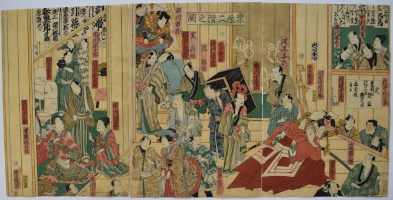
Click here to view image full size.
A fascinating triptych showing the backstage activities on the second floor of a kabuki theatre, Gakuya ni-kai no zu. Twenty-one actors are shown, mostly in their street clothes, together with assistants. However, on the right sheet can be seen an actor in full Shibaraku costume while the centre sheet has Ichikawa Ichizo III descending the stairs. Below is the actor Bando Mitsugoro VI in an onnagata role. On the left sheet can be seen another actor in an onnagata role applying his makeup. This is the bottom half of a hexaptych. Published by Izutsuya Shokichi, c 1861. This design is loosely based on the bottom half of a hexaptych designed by Kunisada in 1856. Rare.
Very good impression and colour. Minor defects, otherwise very good condition. Signed Yoshiiku ga.
Status: Available
Toyohara KUNICHIKA (1835-1900)
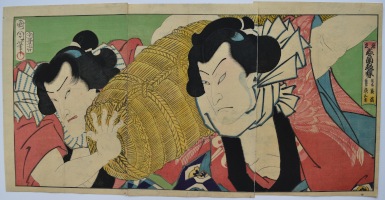
Click here to view image full size.
A triptych with the title Mitate haruzumo futatsu chocho, “An Imaginary Spring Sumo Match with two Butterflies.” A parody of the famous Sumoba, “Sumo Scene” in the pay Futatsu chocho kuruwa nikki, “A Diary of two Butterflies in the Pleasure Quarters.” Shows the actors Ichimura Kakitsu IV (left) as the wrestler Chokichi and Bando Hikosaburo V (right) as his rival Chogoro. The names of both wrestlers begin with “Cho” and two of them together makes “Chocho” which also means “butterfly.” Published by Otaya Takichi, 1866.
Very good impression and colour. Backed, otherwise very good condition. Signed Kunichika ga.
Status: Available
Tsukioka YOSHITOSHI (1839-1892)
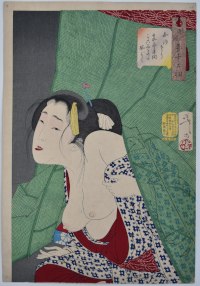
Click here to view image full size.
Looking Itchy: the appearance of a kept woman of the Kaei era [1848-1854]. Shows a beauty emerging from a mosquito net that has apparently not been entirely successful. From a set Thirty-two Aspects of Women published by Tsunashima Kamekichi, 1888. The set depicts women of different backgrounds and occupations from the Kansei era through to the Meiji era with punning allusions to their situation or mood.
Very fine impression with strong blind-printing on the fall. Fine colour and condition. Full size. Signed Hiroshige ga.
Status: Available
Utagawa KUNIYOSHI (1797-1861)
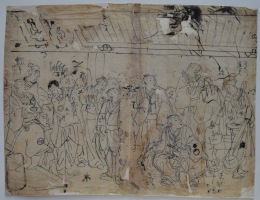
Click here to view image full size.
A large original drawing, sumi on thin paper, 15 x 20 in; 38 x 51 cms. Shows a large group of actors in front of a theatre. Most likely two sheets for an intended triptych. There appears to be the publisher’s seal Kiya Sojuro brushed-in at the bottom who was active c 1851-1904. Provenance: Ex collection Dr. Julius Kurth (1870-1949), an eminent scholar who wrote extensively on Japanese and Chinese art. Sold “as is” with all imperfections.
Status: Available
Nagasawa ROSETSU (1754-1799)
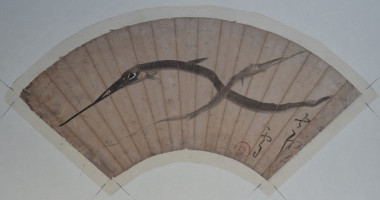
Click here to view image full size.
An original fan painting, sumi on treated paper, 17 x 6.25 in; 43 x 16 cms. Shows two needlefish (family Belonidae).Rosetsu is considered one of the most important artists of the late Edo period but little is known of his short life – he died at forty-five, apart from the fact that he studied and was one of the top disciples of Maruyama Okyo. He is labelled an “eccentric” painter as he defies easy classification. His brushwork is a tour de force and he is known for his expressive depictions of animals. Signed Rosetsu with his Gyo (fish) seal. Framed and glazed with the fan mounted onto Japanese paper. Good condition, apart from the obvious fan folds.
Status: Available
Utagawa KUNIYOSHI (1797-1861)
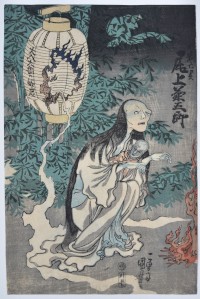
Click here to view image full size.
The actor Onoye Kikugoro III as the ghost of Oiwa from a production of Yotsuya kaidan at the Morita Theatre, 1836. Probably the most famous Japanese ghost story. It was adapted by the playwright Tsuruya Nanboku IV for his friend Kikugoro in 1825. The left panel of a diptych (the right panel being boring and usually ignored). A scene on Snake Mountain showing Oiwa, disfigured by poison, emerging from a burning lantern to haunt her husband, Tamiya Lemon, who had murdered her father. Published by Kawaguchi-ya Chozo, 1836.
Very good impression, colour and condition. Signed Ichiyusai Kuniyoshi ga.
Status: Available
ANONYMOUS (Late 18th century)
Click here to view image full size.
An Uki-e, “floating picture” painting showing an interior with a puppet performance taking place. A puppeteer manipulates a female puppet in the centre, behind him two gidayu narrators and a shamisen player. A male puppet is being held behind a screen. Ladies behind a screen at right enjoy the drama. In fact, a male individual at the back seems overcome by emotion with a hanky to his face. The architecture is represented using one-point perspective, a style which made its way to Japan in the 1740’s from the West via China. (Interestingly the artist has got the perspective wrong on the screen at right.) This genre of painting – invariably unsigned – always shows interior or semi-interior views with banquets or, as here, puppet performances. Full colour on paper, 17 x 23 in; 43.2 x 58.5 cms. Minor marks, although good condition for this kind of painting.
Status:
Available
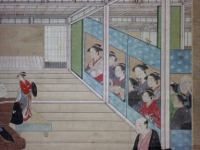
Click here to view image full size.
Utagawa HIROSHIGE (1797-1858)
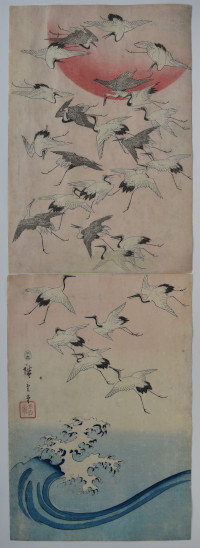
Click here to view image full size.
A vertical diptych showing a multitude of cranes flying up from a cresting wave to a large red sun. In fact this diptych was used by an Edo publisher as end sheets to albums – usually sets of Hiroshige landscapes. Rare: Invariably it is impossible to match the two sheets as the bottom design is always graded blue at the top. Another matching impression is illustrated pl. 143 in Four Hundred Ukiyoe Woodblock Prints From The Museum Of Art, Rhode Island School Of Design, Abby Aldrich Rockefeller Collection Of Japanese Prints, 1990. Another impression is known with a large red seal at a slight angle bottom right. (This may be the first state but rather spoils the design.) Published 5/1858.
Fine impression and colour. Small expertly repaired binding holes, otherwise very good condition. Signed Hiroshige hitsu with Ichiryusai seal.
Status: Sold
Utagawa SADAHIDE (1807-1873)
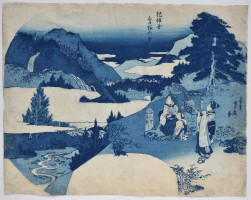
Click here to view image full size.
An aizuri fan print. Shows two travellers admiring the view of the Tama River and Mt. Koya in Kii Province. Published c 1849. Sadahide produced a considerable number of fan prints and it seems to have been a speciality of his. Rare.
Very good impression and colour. Minor edge soil, otherwise very good condition. Uncut. Signed Gountei Sadahide ga.
Status: Sold
Utagawa SADAHIDE (1807-1873)
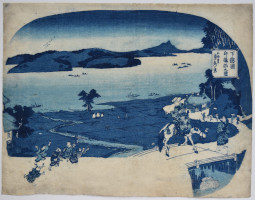
Click here to view image full size.
An aizuri fan print. Shows travellers arriving at Inba Marsh in Shimosa Province. This is now an important wetland habitat for wild birds. Published c 1849. Sadahide produced a considerable number of fan prints and it seems to have been a speciality of his. Rare.
Very good impression and colour. Minor edge soil, otherwise very good condition. Uncut. Signed Gountei Sadahide ga.
Status: Sold
Utagawa SADAHIDE (1807-1873)
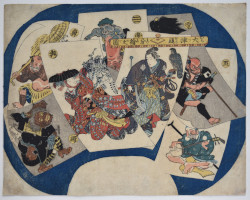
Click here to view image full size.
An uncut fan print showing Otsu-e pictures. (These were cheaply and quickly produced folk images, beginning in the 17th century, sold at an important road junction at Otsu, a port on Lake Biwa. Hence the nomenclature.) Published by Ibaya Senzaburo, c 1849. . Sadahide produced a considerable number of fan prints and it seems to have been a speciality of his. Rare.
Very good impression and colour. Slight edge soil, otherwise very good condition. Uncut. Signed Sadahide ga (on three of the Otsu-e).
Status: Sold
Ichiryusai HIROSHIGE (1797-1858)
Click here to view image full size.
An uncut fan print with title Shinkiro no zu which has a double meaning of being the Yoshiwara in the deep sea and also a chimera or mirage. The scene enclosed in a (dreaming ?) bivalve shows visitors in a watery Yoshiwara, all with fish heads. Of the utmost rarity: This appears to be the only impression known. There are also what appear to be keying marks on three sides that have not been removed. Published by Shinagawaya Kyusuke with censor seal for 1845.
Very fine impression. Fine colour and condition. Signed Hiroshige giga hitsu.
Status: Sold
Katsushika HOKUSAI (1760-1849)
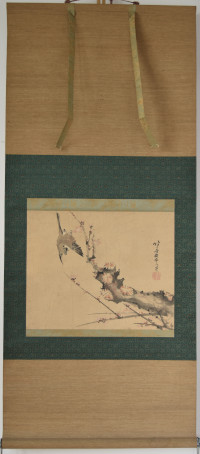
Click here to view image full size.
An original painting, light colour on paper, 13 x 16.5 in; 33 x 42 cms. Shows a sparrow flying over a flowering plum tree. Light soil and creasing, but in generally good condition. Signed Hokusai suichu hitsu, “Hokusai painted while drunk.” Sealed Katsushika. (One of his better-known seals. He used different versions of it throughout his career.)
Status: Sold
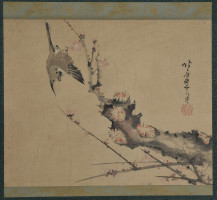
Click here to view image full size.
Tsukioka YOSHITOSHI (1839-1892)
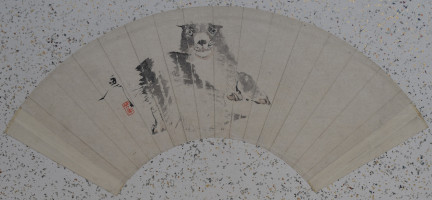
Click here to view image full size.
An original fan painting, sumi on treated paper, 17.5 x 5.5 in; 44.5 x 14 cms. Shows two dogs – possibly Chin. In very good condition: As nearly always, showing the rib folds of the fan. Tipped onto gold-speckled board. Signed and sealed Yoshitoshi.
Status: Sold
Uegaki HORYU (Fl. c 1716-1736)
Click here to view image full size.
An original painting, full colour on paper, 36.5 x 15.5 in; 92.75 x 39.4 cms. Shows a full-length courtesan. It appears there are at least four other Horyu paintings known: Two in the Tokyo National Museum: C0041812 and C0041813; one in the Cleveland Museum of Art; and another in the MFA, Boston, Acc. no. 11.7482. Horyu worked in parallel (and in competition) with the Kaigetsudo atelier. Signed Nihon-e Uegaki Horyu kore o gasu with one Horyu seal; the other unread. The lid of the box is inscribed: Kaigetsudo-ha Uegaki Horyu-hitsu tayu tachi sugata, “A standing figure of a top courtesan brushed by Uegaki Horyu of the Kaigetsudo school.” And on the inside of the lid: Showa hinoto’u uzuki gekan, “Late April of the Fire Rabbit Year [Showa 62/1987].” Appraised by Kimura Suetsuke (a dealer and Ukiyo-e expert). Areas of restoration at bottom and one or two other small areas, but otherwise in very good condition for a painting of this period.
Status: Sold
Utagawa HIROSHIGE (1797-1858)
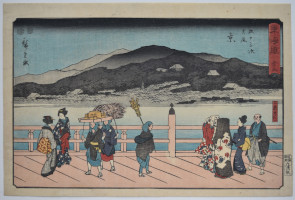
Click here to view image full size.
The great Sanjo Bridge, Kyoto. Number 55 from the Tokaido: Gojusantsugi published by Marusei, c 1848-49. Also known as the Reisho Tokaido. Shows figures on the bridge including Oharame carrying firewood and ladies with katsugi garments. In the distance is Higashiyama and Mt. Hiei.
Fine impression, colour and condition. Signed Hiroshige ga.
Status: Sold
Ichiyusai HIROSHIGE II (1826-1869)
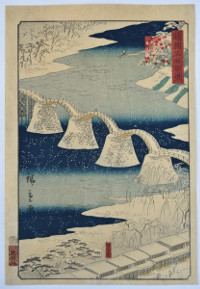
Click here to view image full size.
Suo Iwakuni Kintaibashi, “The Bridge of the Brocade Sash at Iwakuni in Suo Province.” From an uncompleted set: Shokoku meisho hyakkei, “One Hundred Views of the Provinces.” Published by Uoei between 1859 – 1861 (this being 1859). Shows the beautiful five-arch bridge spanning the Nishiki-gawa under heavy snow. The village of Nishikimi in the foreground. The bridge was built in 1673 using massive stone pilings because earlier bridges had been swept away. It was destroyed in 1950 due to a typhoon but rebuilt in 1953. The best print from the set and probably Hiroshige IIs finest design.
Fine impression of the first edition with mica applied. Fine colour. Minor edge discolouration, otherwise very good condition. Later editions lack the variegated cartouche and the colour-banded publisher’s seal in left margin. Signed Hiroshige ga.
Status: Sold
Utagawa HIROSHIGE (1797-1858)
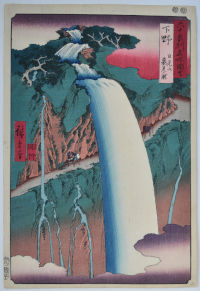
Click here to view image full size.
Shimotsuke Nikkosan urami no taki, “Back-viewed Waterfall on Mt. Nikko in Shimotsuke [Province}.” From a set of 69 prints [Dai Nihon] Rokujuyoshi meisho zue, “Famous Places in the Sixty-odd Provinces [of Japan]” published by Koshihei between 1853 and 1856, this being 1853. Figures gaze up at the back of the waterfall which thunders over the path. It is also known with variant colour schemes. A fine design.
Very fine impression with strong blind-printing on the fall. Very fine colour. Light album backing, otherwise fine condition. Signed Hiroshige ga.
Status: Sold
Utagawa HIROSHIGE (1797-1858)
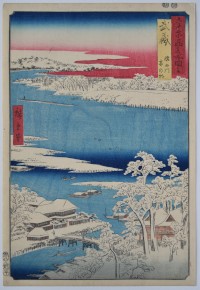
Click here to view image full size.
Musashi, Sumidagawa, yuki no ashita, “Musashi [Province], Sumida River, Morning after Snow.” From a set of 69 prints [Dai Nihon] Rokujuyoshi meisho zue, “Famous Places in the Sixty-odd Provinces [of Japan]” published by b Koshimuraya Heisuke between 1853 and 1856, this being 1853.
Very fine impression and colour. Light album backing, otherwise fine condition. Signed Hiroshige ga.
Status: Sold
Utagawa HIROSHIGE (1797-1858)
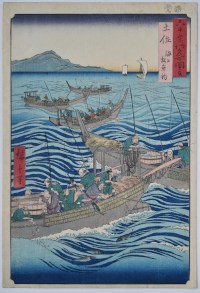
Click here to view image full size.
Tosa, kaijo katsuo tsuri, “Tosa [Province], Bonito Fishing at Sea.” Fishermen used fishing rods, rather than nets, to reduce the stress on the fish and maximise taste. Tosa, located on the southern coast of the island of Shikoku, was famous for its bonito. From a set of 69 prints [Dai Nihon] Rokujuyoshi meisho zue, “Famous Places in the Sixty-odd Provinces [of Japan]” published by b Koshimuraya Heisuke between 1853 and 1856, this being 1855.
Very fine impression and colour. Light album backing, otherwise fine condition. Signed Hiroshige ga.
Status: Sold
Ichiryusai HIROSHIGE (1797-1858)
Click here to view image full size.
An extremely rare chu-tanzaku, Fuyu Sumidagawa no yuki, “Winter Snow on the Sumida River.” From a set Shiki Edo meisho, “Famous Places in Edo in the Four Seasons.” A lone figure in straw cape and large hat poles a log raft down the Sumida river in heavy snow. Published by Kawasho c. 1834. There are a number of states of this design known: As here (probably the earliest) with publisher’s seal and kiwame seal; with kiwame only; and without either. There are also extremely deceiving copies of this print. Provenance: Ex Le Veel collection, sold by Ader Picard Tajan, Paris, 2nd sale, 24/10/1980, lot 114, p. 50.
Very good impression, colour and condition. Signed Hiroshige ga.
Status: Sold
Utagawa KUNIYOSHI (1797-1861)
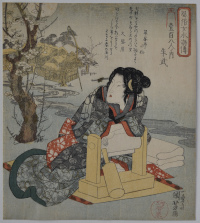
Click here to view image full size.
A surimono from a series: Fuzoku onna Suikoden hyakuhachiban no uchi, “Modern Women as the One Hundred and Eight Heroes of the Suikoden.” Shows a beauty leaning on a fulling block beside a stream. She gazes at a flowering cherry tree with a village in the distance beneath a full moon. Each design is based on one of the characters from the Suikoden; in this case Shinkigunshi Shubu (Zhu Wu), the “Resourceful Strategist.” The series was inspired by a new translation of the 12th century Chinese novel Shui huchuan, “All Men are Brothers” which relates the deeds of a group of outlaws. Commissioned by the Hisakatayaren Club for the New Dragon Year 1832. Surimono were usually issued by these poetry clubs or for specific occasions, although individuals also commissioned them. They could employ every artifice available to the printers and engravers: metal powders, mica, blind-printing and burnishing, and were printed on the best, thick hosho. They were not issued in large numbers as conventional Ukiyo-e and are usually of a smaller format. Presumably ambitiously planned as 108 prints but never completed. Rare.
Very fine impression and colour with silver and gold. Slightly trimmed top and bottom, otherwise very god condition. Signed Ichiyusai Kuniyoshi ga with the red seal of the printer Suriko Shinzo (which is removed on some impressions).
Status: Sold
ANONYMOUS
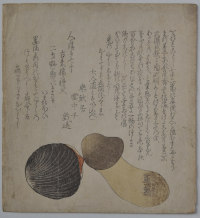
Click here to view image full size.
An unusual and rare surimono showing a matsutake, pine mushroom, and an akagai, red clam. Obvious sexual connotations due to their similarity to the human anatomy. The inscription is enigmatically signed Master In-The-Clouds or Humourously related by the Master who is relaxing and drinking while living in the clouds. With a reference to the Chinese immortal sage Yunzhongzi. Surimono were usually issued by poetry clubs or for specific occasions, although individuals also commissioned them. They could employ every artifice available to the printers and engravers: metal powders, mica, blind-printing and burnishing, and were printed on the best, thick hosho. They were not issued in large numbers as conventional Ukiyo-e and are usually of a smaller format.
Very good impression and colour. Slight soil, otherwise very good condition.
Status: Sold
